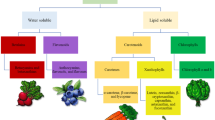Abstract
The dark color occasionally found in crude solvent-extracted oils from a new high-yield brown striped safflower variety originates from colorless precursors in the kernel and precursors in the hull. The precursors from the hull and the pigments formed upon heating from hull and kernel precursors are only partially removed by refining and bleaching if they are present in substantial amounts. The pigment precursors extracted from the kernels are completely removed by precipitation with water or refining. Although substantially more hull and kernel precursors are found in oil from the brown striped safflower variety, the oil can be produced in a spectrographic quality comparable to that of commercial oil if the crude extracted oil is not heated above 100 C, and if extracted and press oils are jointly refined.
Similar content being viewed by others
References
Burkhardt, H. J., JAOCS45, 96–99 (1968).
Burkhardt, H. J., JAOCS47, 69–72 (1970).
Anderson, Clayton and Co., Annual Station Report, Mesa, Arizona, 1964.
Scholfield, C. R., and H. I. Dutton, JAOCS31, 258–261 (1954).
Author information
Authors and Affiliations
About this article
Cite this article
Burkhardt, H.J., Fuller, G. A quantitative evaluation of a color problem in safflower oils. J Am Oil Chem Soc 47, 219–221 (1970). https://doi.org/10.1007/BF02638875
Received:
Issue Date:
DOI: https://doi.org/10.1007/BF02638875




